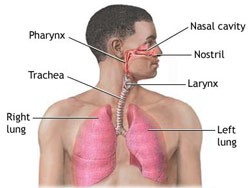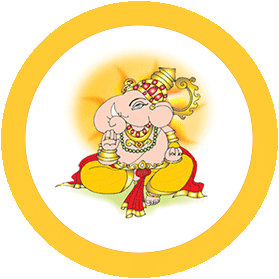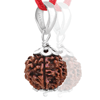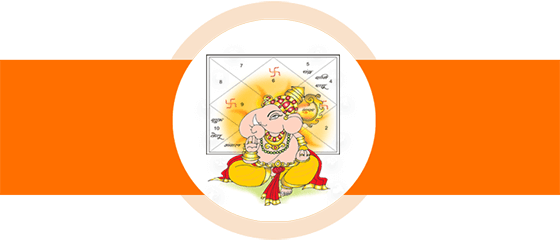Care of The Respiratory Apparatus

According to Yoga, the respiratory movements represent only a portion of the grosser activities of the life force (prana). Pranayama which forms an important accessory of Kriya Yoga really means the control of bionergy, and the regulation of the breathing movements is merely a means to an end.
THE RESPIRATORY ORGANS
The hygiene of the respiratory organs consists in the care of the thorax, the respiratory muscles and the lungs, including the air-passages which lead to them. The thorax or chest-cavity is like a movable cage within which are contained the most important organs of breathing - the lungs, and of circulation - the heart. The muscles of the thorax arc known as intercostals and fill the space between the ribs and complete the chest - walls; and the diaphragm which closes the cavity of the chest below, separating it from the abdomen. The other auxiliary muscles such as the scalene however, are not in use during quiet or normal breathing. In forced breathing, besides the intercostals and the diaphragm, other muscles of the trunk, the larynx, the pharynx and the face are also activated.
Lately, considerable discussion has been raised on the comparative influence of the ribs and the diaphragm during the respiratory arts, (i) A majority of physiologists are of the opinion that the diaphragm is directly responsible for raising the ribs. (ii) On the strength of his recent investigations, Halls Dally maintains that, in raising the ribs, the diaphragm is also assisted by the external intercostals. (iii) A prominent physical culturist, however, holds that it is really the ribs that move the diaphragm. (iv)That all the above views are radically wrong is demonstrated by the fact that respiration can also be carried on independently without the use of the diaphragm. This is especially true in the case of certain methods of yoga breathing, viz., whenever uddiyana is maintained.
The lungs being encased in the thorax have no direct communication with the outside except by means of the respiratory passages. In the normal respiratory act, the air enters these passages through the nostrils or through the mouth - only under certain abnormal conditions - whence it passes through the larynx into the trachea which divides into two branches (bronchi) one to each lung. The lungs have a spongy elastic texture and are composed of numerous minute air sacs or alveoli which connect with the outer air by means of the bronchial tubes. Again, these air sacs are of various forms, depending upon the mutual pressure to which they are subject. The function of these alveoli is to allow the red blood cells to absorb oxygen from the air and to give off the carbon dioxide.
The conditions which prevent the proper functioning and development of the lungs are chiefly the deformities of the thorax and of the spine. These, when not in advanced stages, could be cured through certain corrective yoga postures. But the most common form of attack which threatens the life of every individual practically every moment of his existence is the invasion by a countless number of dangerous microbes as of influenza, pneumonia, diphtheria, tuberculosis and similar infectious diseases upon one or many of the respiratory organs. Even the common catarrh of the nasal origin has been found to have a deleterious effect upon the air-passages and often leads to such inflammatory conditions as tonsillitis, laryngitis, bronchitis, asthma and still more serious consequences. That these dangers could be easily avoided by the proper and timely care of the air-passages and the respiratory apparatus need hardly be emphasized.
Furthermore, the functions of the heart and lungs are intimately connected; and a strongly developed set of respiratory organs adds greatly to the perfect circulation of the blood. The red blood cells which form a major portion of the blood - approximated at seventy - five thousand millions in one cubic inch of blood - are the common carriers of oxygen, taking up a load of oxygen from the lungs to the various tissues of the body.
FOURFOLD ACT OF RESPIRATION
On their return journey, these cells, like a merchant vessel, bring a cargo of waste products of the body and unload the carbon dioxide in the lungs to be thrown away. This cooperation between the lungs and the heart continues from the first sign of life till the end of its existence.
Respiration consists of the alternate expansion and contraction of the thorax by means of which air is drawn into or expelled from the lungs. These two movements are termed inspiration - inhalation, and expiration - exhalation respectively. Yoga holds that the respiratory act is really fourfold wherein each stage is immediately followed by the other, viz., (i) the expiratory standstill or suspensive pause, (ii) inspiration, (iii) inspiratory standstill or retentive pause, and (iv) expiration. Yoga also maintains and quality of the air inhaled and the rhythm and completeness with which the four major acts of respiration are performed.
Astrological services for accurate answers and better feature
Astrological remedies to get rid of your problems

AstroSage on MobileAll Mobile Apps
AstroSage TVSubscribe
- Horoscope 2026
- राशिफल 2026
- Calendar 2026
- Holidays 2026
- Shubh Muhurat 2026
- Saturn Transit 2026
- Ketu Transit 2026
- Jupiter Transit In Cancer
- Education Horoscope 2026
- Rahu Transit 2026
- ராசி பலன் 2026
- राशि भविष्य 2026
- રાશિફળ 2026
- রাশিফল 2026 (Rashifol 2026)
- ರಾಶಿಭವಿಷ್ಯ 2026
- రాశిఫలాలు 2026
- രാശിഫലം 2026
- Astrology 2026


































